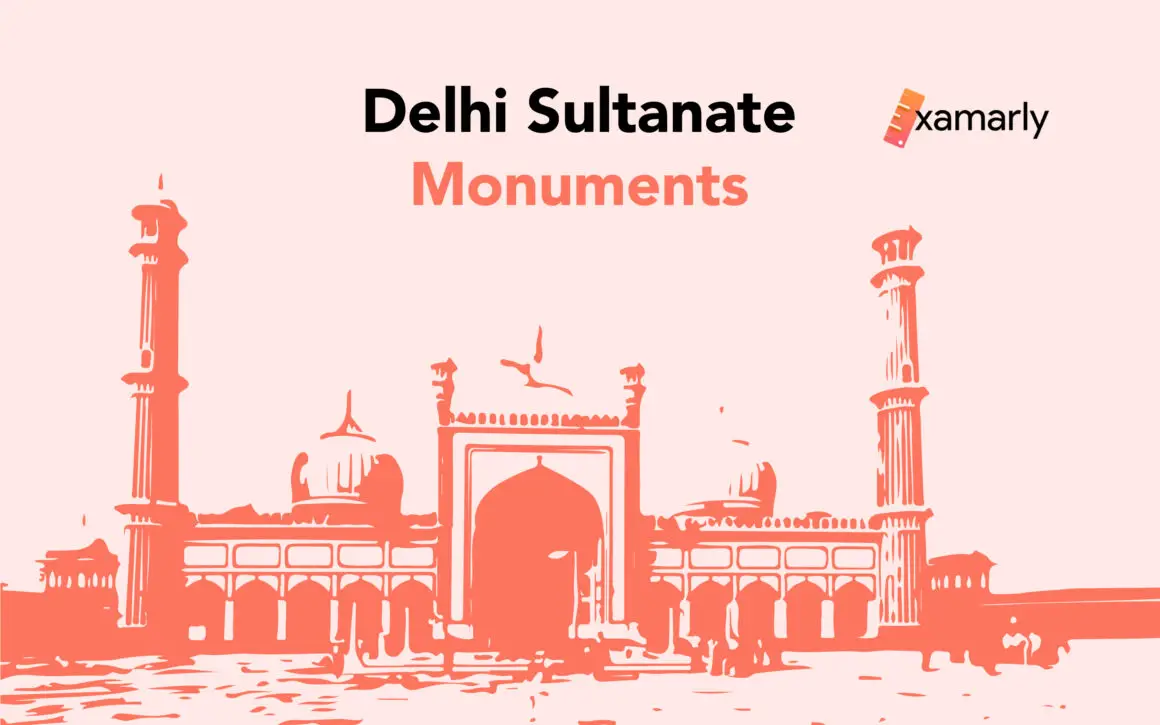Do you want to know about the exquisite Delhi sultanate monuments? With its capital in Delhi, the Delhi Sultanate ruled over a sizable portion of South Asia for 320 years (1206–1526). Five dynasties successively controlled the Delhi Sultanate, namely
- Mamluk dynasty (1206-1290)
- Khalji dynasty (1290-1320)
- Tughlaq dynasty (1320-1414)
- Sayyid dynasty (1414-1451)
- Lodi dynasty (1451–1526).
The Delhi Sultanate included vast portions of the Indian subcontinent or what is now modern-day Bangladesh, Pakistan, and India, as well as sections of southern Nepal.
This article on Delhi Sultanate monuments will be beneficial for UPSC exam preparation. This blog also has an introduction that highlights the grandeur and historical significance of the monuments that were built during the Delhi Sultanate period.
- Why Delhi Sultanate Period is Golden Age of Medieval India?
- The Architecture Of The Delhi Sultanate
- Delhi Sultanate Monuments: Unique Features
- 14 Breathtaking Delhi Sultanate Monuments
- 1. Adhai Din Ka Jhopra
- 2. Moth Ki Masjid
- 3. Jammat Khana Masjid Or Khilji Mosque
- 4. Quwwat-ul-Islam Mosque
- 5. Nizamuddin Dargah
- 6. Tomb Of Ghiyasuddin Tughlaq
- 7. Alauddin Khilji's Tomb And Madrassa
- 8. Qutub Minar
- 9. Alia Minar
- 10. Alai Darwaza
- 11. Tughlaqabad Fort
- 12. Lodhi Garden
- 13. Jama Masjid
- 14. The Hauz Khas Complex
- Conclusion
- Frequently Asked Questions
- What are the top Delhi Sultanate monuments to visit in Delhi?
- Who built the Qutub Minar and when?
- What is the significance of the Red Fort in Delhi?
- What is the history of the Tughlaqabad Fort in Delhi?
- What is the significance of the Jama Masjid in Delhi?
- What are the key features of Indo-Islamic architecture?
- What is the history of the Hauz Khas Complex in Delhi?
- What is the significance of the Alai Darwaza in Delhi?
- What is the history of the Lotus Temple in Delhi?
- What is the significance of the Tughlaqabad Tomb in Delhi?
Why Delhi Sultanate Period is Golden Age of Medieval India?
Delhi Sultanate period was a time of significant political, economic, and cultural development, and it left an enduring legacy that continues to shape Indian society and culture today.
Political stability, economic prosperity, cultural exchange, administrative reforms and military reforms were some of the reasons for the exemplary title.
This period was also marked by the construction of several iconic Delhi Sultanate monuments that continue to stand as a testament to the era’s cultural and architectural achievements.
Many of the Delhi Sultanate monuments combine elements of Islamic and Indian architectural styles, creating a unique fusion that is now known as Indo-Islamic architecture. Here are a few of the most notable Delhi Sultanate monuments:
- Qutub Minar: Qutub Minar is located in Delhi, it is a towering minaret that stands over 73 meters tall. It was built by Qutb-ud-din Aibak, the first Muslim ruler of Delhi, in the late 12th century.
- Alai Darwaza: The Alai Darwaza is another iconic monument of the Delhi Sultanate period. Located in the Qutub Complex in Delhi, it is a beautiful example of Indo-Islamic architecture. It was built by the Khilji dynasty in the 14th century and features intricate carvings and beautiful calligraphy.
- Jama Masjid: The Jama Masjid is one of the largest and most well-known mosques in India. It was built by the Mughal emperor Shah Jahan in the mid-17th century and features a stunning mix of Mughal and Persian architectural styles. The mosque can accommodate up to 25,000 worshippers at a time.
- Tomb of Ghiyas-ud-din Tughlaq: The Tomb of Ghiyas-ud-din Tughlaq is a beautiful example of Indo-Islamic funerary architecture. It was built in the 14th century by the Tughlaq dynasty and features a striking red sandstone exterior.
- Hauz Khas Complex: The Hauz Khas Complex is a sprawling complex of buildings that were built during the Delhi Sultanate period. It includes a mosque, a tomb, and a madrasa, and is known for its intricate carvings and beautiful gardens.
Related: History Optional for UPSC
The Architecture Of The Delhi Sultanate
The architectural landmarks of the Delhi Sultanate period was a combination of different faith and region. The mix of Arab and Indian styles along with the addition of Islamic and Delhi Sultanate monuments led to the creation of Hindu-Muslim architecture styles.
It was a unique work of art created by skilled craftsmen of both faiths. Also, these Delhi Sultanate monuments built during the Delhi sultanate depict the socioeconomic and political conditions of that time.
Thus, these architectural wonders are a source of information on Indian architecture and history.
To know more about the Art And Architecture Of the Delhi Sultanate visit the linked article.
Delhi Sultanate Monuments: Unique Features
Incredible architectural development took place during the Sultanate period. Delhi Sultanate encouraged the use of new and unique building designs and methods.
This was also a period of great artistic achievement. This is evident in the many beautiful architecture and Delhi Sultanate monuments that remain today.
Also, the features of these Muslim buildings were quite different from the then-common Hindu buildings. Beautiful mosques, tombs, pillars, and forts became common after the Islamic conquest.
The mosques and tombs that the Muslim nobles demanded were different from the previous huge structures that were constructed in India. Both buildings’ exteriors had many arches and enormous domes as roofs.
Hindu temple architecture and other native Indian forms seldom ever employed either of these aspects. Both sorts of structures forgo the figurative sculpture vital to Hindu temple construction and instead contain one huge room under a tall dome.
Many tombs in Delhi have two-domed ceilings, which are often called false domes and true domes. The Delhi Sultanate saw a dramatic change in architecture and two domes were common.
The house’s roof is the internal dome, while the external dome crowns it. Two domes allow for a lower ceiling while keeping the exterior elevation proportions intact. Early trials of the Double Dome feature on tombs of Sultan Sikandar Lodi.
Yet, it was not until the Humayun tomb that the concept fully matured. The Mughal era saw the double dome as a key feature in the construction and maintenance of Delhi Sultanate monuments. This style is best illustrated by the Taj Mahal, which has two separate domes.
In place of the polychrome tiles seen in Persia and Central Asia, the Indo-Islamic style of architecture adopted strikingly contrasting colours of masonry, such as red sandstone and white marble. This would later become a regular element in Islamic architectural styles.
The inside margins of the pointed arches are not cusped but rather lined with conventionalized “spearhead” projections. The pointed arches’ bases are slightly converging to provide a small horseshoe arch appearance. Here, stone openwork screens known as jali came into use.
Similar Posts
- Tughlaq Dynasty: Medieval Indian History UPSC Notes
- Khilji Dynasty: Medieval Indian History UPSC Notes
- Lodi Dynasty: Medieval Indian History Notes
14 Breathtaking Delhi Sultanate Monuments
Let us brush through some of the historic buildings and monuments built by Delhi sultans during the Delhi Sultanate period. These are categorized into 3 sections for merely easy reading. Read on and learn.
Let’s look into the striking Delhi Sultanate monuments below:
1. Adhai Din Ka Jhopra
The Adhai Din Ka Jhonpra is a huge and impressive structure located in Ajmer, India. It was commissioned by the sultan Qutub ud-din Aibek in 1192 CE. Abu Bakr of Herat, an architect who accompanied Muhammad Ghori, designed it.
The mosque was constructed by Hindu masons directed by Afghan supervisors. The structure is surrounded by a seven-arched wall and is a stunning example of early Indo-Islamic architecture. The mosque was completed in 1199 CE.
Later, Iltutmish from Delhi added to it. Up until 1947, the building was a mosque. The building became supervised by the ASI (Archaeological Survey of India) Jaipur circle when India attained its independence.
Today, people of all faiths visit it as a beautiful example of a fusion of Indian, Hindu, Muslim, and Jain structures.
2. Moth Ki Masjid
Moth ki Majid is one of the most prominent mosques and Delhi Sultanate monuments in India. It was built approximately 500 years ago. The Moth ki Masjid is a historic landmark in Delhi.
It was built in 500 AD by the Lodi clan. Its name means “Lentil Mosque” which refers to the fact that the proceeds of the sale of lentils helped in its construction.
The red stone structure, double-storeyed towers, and semi-circular dome make it a unique Indo-Islamic architectural marvel. Beautiful decoration adorns Moth ki Masjid’s exterior.
The dome-shaped chhatri of the Moth ki Masjid is covered with blue tiles. The gates are carved in a style similar to Hindu temples.
The main gateway and entrance are decorated with square pillars and elephant trunk carvings. Many stone carvers were Hindu, and this influenced the architecture at the Moth Ki Masjid.
It is a great place to worship due to its simple yet striking design. It is also notable for its latticework in the windows
3. Jammat Khana Masjid Or Khilji Mosque
The Khilji mosque is Delhi’s oldest mosque that is still in use for prayer. The mosque was built in 1315-1325 AD by Khizr Khan, son of Sultan Alauddin Khilji It is the biggest monument in the Dargah enclosure.
As is customary, each of the three bays has a domed ceiling, with the central one being the biggest. The domes’ tops are adorned with marble finials.
Bands of magnificent geometric designs and Quranic verses adorn the centre bay and the entry arches. This would be the first conservation or restoration of monuments project at a mosque of worship in Delhi, if not India.
4. Quwwat-ul-Islam Mosque
The Quwwat-ul-Islam mosque is also known as the Qutub Mosque or the Great Mosque of Delhi. It was commissioned by Qutb-ud-din Aibak, the founder of the Mamluk or Slave dynasty.
This is one of the Delhi Sultanate monuments that was constructed with spoils from 27 temples on the site of a huge temple in the heart of a fortification.
Built on the ruins of ancient temples, the Quwwatul-Islam mosque is Ghurids-inspired. Many of the stones used in the construction of the mosque were taken from the Jain temple ruins.
The building is also made out of brick and mortar and contains many Hindu motifs. The Quranic inscription is the first sign of the mosque’s Islamic character.
Quwwat-ul-Islam Mosque houses a stunning screen. It is a 16-meter-high, stone arch that is surrounded and framed by two smaller arches.
The screen, made of red and white sandstone, is richly decorated. Iltutmish finished the screen in 1229. The mosque was further extended by Ala-ud-din Khilji in 1311.
5. Nizamuddin Dargah
The Nizamuddin Dargah is an Islamic shrine located in Delhi’s Nizamuddin West. The Nizamuddin Dargah is one of the most famous Sufi shrines in the world.
It houses the tomb of Hazrat Nizamuddin Auliya (one of the most well-known Sufi saints). There are many reasons that you should visit Nizamuddin Dargah.
The dargah houses the graves of Muhammad’s favourite sons and daughters. This shrine also houses Jahanara Begum, Shah Jahan’s favourite daughter.
Religious pilgrims from all parts of the world visit this shrine. The location is known as the “nerve centre of Sufi culture in India.”
Many music fans also come to hear the traditional Sufiqawwali music which is played on Thursdays.
Nizamuddin Dargan is one of the Delhi Sultanate monuments that is especially well-known for its nighttime performances of qawwali devotional music. The descendants of Nizamuddin Auliya oversee the whole operation of Dargah Sharif.
6. Tomb Of Ghiyasuddin Tughlaq
Ghiyas ud-Din Tughluq founded the Tughluq dynasty in India. He planned to establish the new fortified city of Tughluqabad quite near to the former capital in Delhi.
It is believed that Ghiyas erected a tomb for himself at Multan when he was governor. Yet, after becoming Sultan, he chose to construct another for himself in Tughluqabad.
The tomb was created in 1325. It is made of red sandstone and white marble, both of which were extensively employed in Islamic constructions during the period.
It features a white marble dome. Instead of vertical walls, the tomb has sloping walls that form a 75-degree angle with the earth. This architectural style is comparable to the sloping walls of Mandu’s Hindola Mahal (Swing Palace).
The tomb building is square in plan and contains three graves. Besides Ghiyas-Ud-Din Tughluq’s grave in the centre, the other two are that of his son, Muhammad bin Tughluq, and his wife, Makhdum-i-Jahan. It is surrounded by a private courtyard.
It is designed in the Indo-Islamic style. It has three arched entrances with a pointed dome supported by an oval drum.
7. Alauddin Khilji’s Tomb And Madrassa
Qutb Complex in Delhi is home to Alauddin Khilji’s madrassa as well as the tomb. It is composed of three buildings enclosed by a common wall. It was built in 1315 by Alauddin Khalji.
His grave is inside the madrasa. It is believed to be the first tomb-madrassa combination in India. Such a tomb within a madrasa structure is a characteristic of the architecture of the Seljuk Empire.
The tomb complex is an L-shaped building that has seven rooms. Two of these are domed. The tomb of Alauddin Khalji is placed in the southern wing’s centre chamber.
The western wing of the madrasa is made up of seven tiny cells and two high-domed halls. The domes are “high-drummed,” with corbel arched gates underneath.
The domes of these chambers are supported by corbelled pendentives, which were used for the first time in India. The cubicles were most likely utilized as residences.
8. Qutub Minar
The Qutb Minar is a minaret and “victory tower” that is part of the Qutub complex. It is located on the grounds of Lal Kot, Delhi’s oldest walled city established by the Tomar Rajputs.
It is a UNESCO World Heritage Complex. It was largely constructed between 1199 and 1220. This victory tower represents a fusion of traditional Islamic architecture with Southwestern Asian style.
It is comparable to the 62-meter all-brick Minaret of Jam in Afghan architecture built in 1190.
Standing tall at 72.5 meters, Qutb Minar the highest minaret made of brick in the world. The base diameter of the tower is 14.3 meters (47 feet), tapering 2.7 meters (9 feet) at the apex.
It has a spiral staircase of 379 steps. A spiral staircase of 379 steps runs the length of the tower. The Quwat Ul Islam Mosque is located at the base of the tower. The Minar is tilted a little more than 65 cm from vertical.
9. Alia Minar
The Alai Minar is an unfinished structure located in South Delhi’s Qutb complex. Sultan Alauddin Khilji was an ambitious Khilji dynasty Sultan who won many wars and battles.
Following a victory in one of his Deccan wars, the Sultan envisioned erecting a massive Tower or Minar to celebrate his achievement. He desired a building that was double the height of the Qutub Minar.
This way, he would be recognized as the only Sultan who dared to build such a gigantic masterwork that was greater than the Qutub Minar of the Slave dynasty that ruled before him.
This second minaret was abandoned during the early stages of the building. Sultan died and the building didn’t grow anymore. What remained was a 24.5-meter-tall tower base near Qutub Minar.
10. Alai Darwaza
The Alai Darwaza is a beautiful example of Islamic architecture. It is the oldest door in Delhi and is a jewel of Islamic architecture.
It was built by Alauddin Khilji in 1311 AD, one year before his death. It was part of a larger project to beautify Qutab Minar’s grounds. It is a World Heritage Site.
The Ala’i Darwaza is the southern gatehouse of the Quwat-ul-Islam Mosque at Mehrauli, Delhi. It was constructed from red sandstone and features arched entrances.
The Alai Darwaza consists of a single hall. The 1311 gatehouse nonetheless demonstrates a cautious attitude to new technology, with exceptionally solid walls and a shallow dome visible only from a specific distance or height.
The use of contrasting brick colours, like as red sandstone and white marble, introduces what would become a frequent aspect of Indo-Islamic architecture.
The Darwaza’s walls have Islamic calligraphy. The arches are horseshoe-shaped, and this is the first time such arches were used in India.
11. Tughlaqabad Fort
The Tughlaqabad Fort is a ruined fort located in Delhi. It was built by the Tughlaq dynasty during the thirteenth century and abandoned after 1327. Ghiyasuddin Tugluq founded the fort in 1321. The fort is approximately 6.5 kilometres long with many architectural structures.
The tomb of Ghiyas-ud-din is located south of the main entrance. The causeway leads to it via six-foot-wide arches. The tomb consists of a square-domed tomb with a sloping wall. The inside of the tomb has white marble and slate decorations.
According to legend, Tughlaq was so passionate about this ideal metropolis that he ordered every labourer in the Sultanate of Delhi to work on its construction.
Sufi saint Nizamuddin Auliya was building a stepwell at his home at the same time that the city and fort were being created. He couldn’t get labourers to build his stepwell since everyone was busy building the fort.
As a result, labourers would work on the fort during the day and construct the stepwell at night. The conflict between the Sufi saint and the regal ruler has become a legend. The saint issued a curse that would reverberate across history till the present day.
12. Lodhi Garden
Lodhi or Lodi Gardens is 90 acres of a city park in New Delhi. The park contains many historical monuments such as the Tomb of Sikandar Lodi and Mohammed Shah’s Tomb.
The park is also home to several architectural works such as Shisha Gumbad or Bara Gumbad. Post-Independence, it was redesigned in 1968, by J.A. Stein, an eminent architect.
Some of the buildings are protected by the Archaeological Survey of India and others by the State Department of Archaeology, Delhi.
The garden’s historical past is proof of how the city now includes within itself a rich heritage with its undulating walking routes and running lanes bordered by old trees, colourful shrubs, and floral plants.
The garden is well-known for its beautiful architecture and is a popular location to shoot models, hold wedding ceremonies, or host house parties.
It’s also a great location for a romantic picnic. Lodhi is a popular spot not only for bird watching but also for picnicking and other outdoor activities.
13. Jama Masjid
Jama Masjid is a historic mosque located in the heart of Old Delhi, and it is widely regarded as one of the most important and iconic monuments of the Delhi Sultanate period.
The mosque was built by the Mughal emperor Shah Jahan in the mid-17th century, and it remains one of the largest and most well-known mosques in India today.
One of the most striking features of the Jama Masjid is its architectural style. The mosque features a stunning blend of Mughal and Persian architectural elements, which creates a unique fusion that is now known as Indo-Islamic architecture.
The mosque is built from red sandstone and white marble, and it features beautiful carvings, intricate patterns, and stunning calligraphy.
The Jama Masjid is also notable for its size and capacity. The mosque can accommodate up to 25,000 worshippers at a time, making it one of the largest mosques in India.
The mosque’s courtyard alone can hold up to 95,000 people, which is a testament to the scale and grandeur of the mosque’s design.
14. The Hauz Khas Complex
The Hauz Khas Complex is a historic site located in the Hauz Khas neighbourhood of New Delhi, and it is considered to be one of the most important examples of Delhi Sultanate architecture.
The compound comprises a mosque, a tomb, and a madrasa, renowned for their intricate carvings and splendid gardens.
The complex was built during the 13th century under the reign of Alauddin Khilji, one of the most famous rulers of the Delhi Sultanate period.
The centrepiece of the complex is a large water tank that was used to supply water to the local community. Surrounding the tank, several buildings were used for religious and educational purposes.
One of the most striking features of the Hauz Khas Complex is its intricate carvings and beautiful gardens.
The buildings are adorned with intricate geometric patterns, calligraphy, and other decorative elements that reflect the Islamic influence on the architecture of the Delhi Sultanate period.
The gardens surrounding the complex are also beautifully designed, and they include fountains, pathways, and shaded areas that were used for relaxation and contemplation.
Conclusion
Why should anyone learn about the earliest mosques, tombs, and buildings made centuries ago? Well, to begin with, they are relics of our past. They define our roots, our history, and the mesmerizing grip our ancestors had over art and architecture.
The impressive buildings constructed during the Delhi Sultanate reign have historical as well as cultural value. The ancient building materials, styles of construction of buildings, reasons behind their commission, and their present stature say a lot about our heritage.
Additionally, they have added to Delhi tourism and the tourism of North India in measures we cannot even imagine.
Hope we have covered the most beautiful Delhi Sultanate monuments in this blog. Do brush through these facts and look up pictures to get a better aesthetic sense of their architecture.
Frequently Asked Questions
What are the top Delhi Sultanate monuments to visit in Delhi?
Some of the top monuments from the Delhi Sultanate period in Delhi include the Qutub Minar, Red Fort, Jama Masjid, Tughlaqabad Fort, and Hauz Khas Complex.
Who built the Qutub Minar and when?
The Qutub Minar is one of the best Delhi Sultanate monuments that was built by the Delhi Sultanate ruler Qutub-ud-din Aibak in the 12th century. It was later completed by his successors.
What is the significance of the Red Fort in Delhi?
The Red Fort was built by the Mughal emperor Shah Jahan during the 17th century, and it served as the residence of Mughal emperors until 1857. Today, it is a UNESCO World Heritage Site and a popular tourist destination.
What is the history of the Tughlaqabad Fort in Delhi?
The Tughlaqabad Fort was built by the Delhi Sultanate ruler Ghiyas-ud-din Tughlaq in the 14th century. It was one of the most important Delhi Sultanate monuments and fortifications of the period and played a key role in defending the city against invading forces.
What is the significance of the Jama Masjid in Delhi?
The Jama Masjid is one of the largest and most well-known mosques in India, and it was built by the Mughal emperor Shah Jahan in the mid-17th century. It is a popular destination for worshippers and tourists alike.
What are the key features of Indo-Islamic architecture?
Indo-Islamic architecture is a unique blend of Indian and Islamic architectural styles that emerged during the Delhi Sultanate period. It features elements such as domes, arches, calligraphy, and intricate geometric patterns.
What is the history of the Hauz Khas Complex in Delhi?
The Hauz Khas Complex is a sprawling complex of buildings that were built during the Delhi Sultanate period. It includes a mosque, a tomb, and a madrasa, and is known for its intricate carvings and beautiful gardens.
What is the significance of the Alai Darwaza in Delhi?
The Alai Darwaza is a famous gateway located in the Qutub Minar complex. It was built by the Delhi Sultanate ruler Alauddin Khilji in the 14th century and is known for its striking architecture and intricate decorative elements.
What is the history of the Lotus Temple in Delhi?
The Lotus Temple is a modern architectural marvel in Delhi that was completed in 1986. It is known for its distinctive lotus-shaped design and its unique use of concrete and marble.
What is the significance of the Tughlaqabad Tomb in Delhi?
The Tughlaqabad Tomb is a historic mausoleum located in Delhi that was built by the Delhi Sultanate ruler Ghiyas-ud-din Tughlaq in the 14th century. It is known for its impressive architecture and its unique blend of Indian and Islamic styles.






